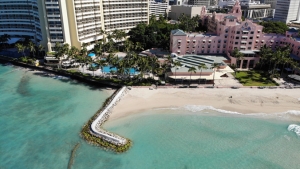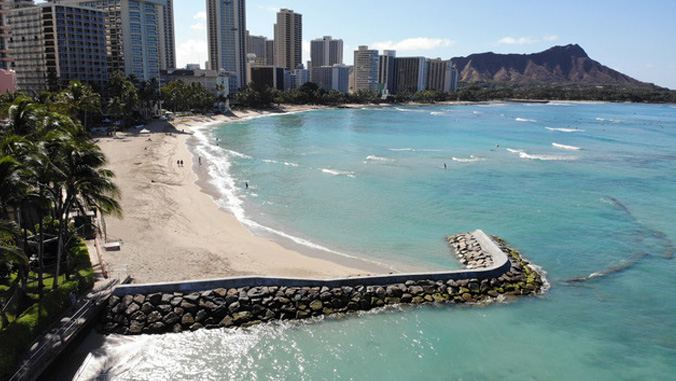The first construction project in Waikīkī Beach in 50 years, which marks the beginning of a new era of renewal and recovery, started with the replacement of the Royal Hawaiian groin. Built in 1927, the original curving cement wall was built to prevent erosion. The new rock groin is replacing the old one with a similar role and function but is much more robust, providing a more stable beach and will be followed by more beach improvement projects including additional beach sand over the next several years.
The replacement groin is designed to maintain the approximate beach width of the 2012 Waikīkī Beach maintenance shoreline nourishment project. No enlargement of the beach or additional sand nourishment is involved in this project.
During this project, the University of Hawaiʻi Sea Grant College Program (Hawaiʻi Sea Grant) played an essential role in providing technical project management and coastal science and policy support to the Waikīkī Beach Special Improvement District Association (WBSIDA) which serves as a public private partnership with the state paying for 50 percent of the $1.5 million project cost.
The project began in early May and is expected to be completed in late July. Originally scheduled for September 2020 to avoid the busy summer season, it was accelerated after the COVID-19 pandemic shut everything down and presented a once-in-a-lifetime opportunity to do heavy construction without interfering with hotel or recreational beach activities.
Dolan Eversole, the Waikīkī Beach management coordinator with Hawaiʻi Sea Grant, coordinated with stakeholders and agencies involved and conducted regular project oversight and environmental monitoring, while also serving as technical project oversight on behalf of the Department of Land and Natural Resources (DLNR).
“This project improves the resilience of this beach and will stabilize an extremely important and valuable natural resource,” said Eversole. “Stabilizing the beach system will also reduce the amount of sand migrating offshore which can cause problems for the coral reefs and surf sites if unmanaged.”

The Royal Hawaiian groin was more than 90-years-old and at risk of failure due to deterioration. Structural engineers determined it was leaking sand and contained large voids, cracks, bowing and no apparent internal reinforcement. Its failure would have resulted in the destabilization and eventual loss of more than 1,700 feet of sandy shoreline located east of the groin.
- Related UH News story: UH Sea Grant called on to help save Waikīkī Beach, June 17, 2019
The new structure was built around the remnants of the old vertical wall groin and constructed in an L-shaped design. The replacement groin serves to stabilize the beach in the western end of the Royal Hawaiian and will mitigate the extreme seasonal beach erosion which has become more frequent recently in that area.
“Looking ahead, we are actively working with the DLNR on an Environmental Impact Statement (EIS) and master plan for Waikīkī Beach that includes resilient design features that account for future sea-level rise and the acceleration of beach erosion, this type of planning for future conditions is a crucial part of designing and supporting resilient communities and economies and demonstrates the successful partnership that has developed between UH, the WBSIDA and the DLNR,” said WBSIDA President Rick Egged.
A successful partnership
The important UH partnership with WBSIDA and the DLNR to improve and manage Waikīkī Beach has proved to be successful. Hawaiʻi Sea Grant continues to provide scientific and technical support and outreach to a wide variety of Waikīkī stakeholders and government officials. Hawaiʻi Sea Grant also conducts regular outreach, education and policy review for issues such as climate change, sea-level rise, coastal erosion, beach and reef management and now economic recovery.
“The University of Hawaiʻi plays a key role in serving as a respected neutral broker of coastal science and beach management policy and practice,” said Eversole. “The community in Waikīkī can access all kinds of information and ask questions through the extension and outreach provided by the university. It also serves in an important role conducting environmental and economic research, science, engineering and coastal management policy to better observe and provide information that assists decision-makers in improving the management of the area.”
Additional details on the Royal Hawaiian Groin project can be found at WBSIDA’s website.
—By Sarah Hendrix


